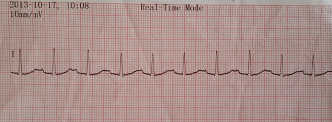ECE2014 Poster Presentations Thyroid (non-cancer) (125 abstracts)
A case of thyrotoxic hypokalemic periodic paralysis presenting with ‘U’ wave on ECG
Emre Gezer 1 , Banu Sarer Yurekli 2 & Gokcen Unal Kocabas 2
1Department of Internal Medicine, Izmir Bozyaka Training and Research Hospital, Izmir, Turkey; 2Division of Endocrinology and Metabolism, Izmir Bozyaka Training and Research Hospital, Izmir, Turkey.
Introduction: Hypokalemic periodic paralysis (HPP), is a rare neuromuscular disorder caused by dysfunction of the ion channels in red muscle cells which is characterized by painless episodes of muscle weakness generally after strenuous exertion or a high-carbohydrate meal. However, some HPP patients secondary to thyrotoxicosis are also described.
Case: A 41-year-old Caucasian man, without any chronic disease, presented to our emergency department with generalized muscle weakness pronounced in his both upper and lower extremities. He recalled many similar but milder episodes in the previous 2 months. The physical examination made by a neurologist had no pathology but only quadriparesis. His initial potassium level was 1.5 mEq/l on admission and his electrocardiogram showed an obvious U wave (Figure 1). An initial diagnosis of hypokalemic periodic paralysis was made and he was immediately given intravenous potassium chloride in the emergency department. It was learned that he had no family history and he had a high-carbohydrate diet a few hours before the quadriparesis occurred. Physical examination revealed a slightly enlarged thyroid gland without nodules and exophthalmos was present. TSH level was <0.03 μU/ml (0.25–5.0), fT4 level 4.21 ng/dl (0.77–1.71), and fT3 19.55 ng/dl (0.23–0.39). Under these findings, the patient was diagnosed as having thyrotoxic hypokalemic periodic paralysis associated with Graves’ thyrotoxicosis and treatment with methimazole was initiated. Serial measurements of his serum potassium level which was too low on admission and then became normal after administering intravenous potassium chloride, remained within normal limits without any oral potassium supplements in the hospital. Treatment with propranolol was also initiated as 4×40 mg/day.
Discussion: The pathogenesis of THPP is the activation of Na+/K+-ATPase pump because of hyperinsulinemia, increasing of thyroid hormones and beta-adrenergic stimulation. Therefore, B receptor blockage, anti-thyroid drugs and low-carbohydrate meals are recommended for treatment and prophylaxis of THPP.





